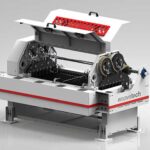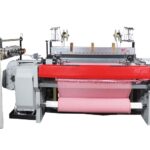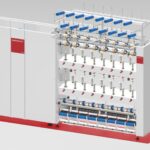Rapier Weaving Machine: Types, Weft Insertion System, Electronic Control, and Development
Rapier Looms: Innovation in Modern Weaving | Weavetech Textile Machinery

The weaving industry has evolved tremendously from shuttle looms operated by hand to high-speed, electronically controlled machines. At the heart of this evolution are the Rapier Looms, a technology that has transformed the textile industry by providing speed, versatility, and efficiency.
For a company, such as Weavetech, where innovation is driven by weaving, rapier technology is not just a tool but a symbol of advancement that allows weavers to produce fabrics with quality and precision that are not otherwise available. In this blog, we shall discuss the varieties of rapier weaving machines, their weft insertion systems, electronic control, and how constant innovation in Rapier Looms has transformed the textile industry today.
What are Rapier Looms?
Rapier Looms are shuttleless looms in which slim rods, known as rapiers, transport the weft yarn through the warp shed. In contrast to older shuttles, rapier technology is faster, kinder to yarn, and versatile enough to make a great range of fabrics.
From light silks to heavy upholstery fabrics, Rapier Looms offer the versatility that contemporary weavers demand. Being capable of achieving high-speed production and precision makes them one of the best-used weaving technologies across the globe.
Types of Rapier Weaving Machines
- Single Rapier Looms
One rapier transports the weft yarn across the loom. Although mechanically straightforward, these machines are not found as frequently nowadays due to their slower performance relative to contemporary systems.
- Double Rapier Looms
More widely used in industrial weaving, double rapier looms employ two rapiers, one from each direction. The weft yarn is transferred in the middle of the shed, and handed over to enable easy insertion and greater productivity.
This double system is a hallmark of modern Rapier Looms as it allows greater speed, less yarn stress, and broader fabric possibilities. At Weavetech, our rapier machines integrate this system to deliver the perfect combination of speed and quality.
Weft Insertion System in Rapier Looms
One of the greatest strengths of Rapier Looms is their advanced weft insertion system, which eliminates the limitations of shuttle-based weaving.
There are two key methods:
- Rigid Rapier System – Employs solid rods to support the weft. Efficient but best for narrower fabric widths.
- Flexible Rapier System – Employs flexible tapes or bands, making it possible to weave up to 360 cm or wider. This is the system utilised in contemporary Rapier Looms, such as Weavetech’s superior machines, because it marries speed with flexibility.
The outcome? Smoother transfer of the weft, less yarn breakage, and easier handling of complex or fancy yarns.
Role of Electronic Control in Rapier Looms
Electronic implementation has propelled Rapier Looms to intelligent solutions for weaving. The machines today are not just mechanical powerhouses but digitally accurate instruments.
Electronic control plays key roles that include:
- Automatic Surveillance – Identifies warp or weft breaks immediately and stops the loom to avoid fabric defects.
- Pattern Regulation – When integrated with dobby or jacquard technology, electronic controls enable the production of complex and high-value designs.
- Speed Efficiency – Electronic drives control the loom movement, reducing vibration and increasing lifespan.
- Energy Efficiency – With optimised control, power usage is minimised, reducing operating costs.
Weavetech’s rapier looms come equipped with advanced electronic features, ensuring that weavers achieve both higher productivity and consistent quality with minimal downtime.
Development of Rapier Looms
The journey of Rapier Looms reflects the constant drive for progress in textile engineering.
- Early Phase – Simple mechanical models introduced the concept of shuttleless weaving.
- Flexible Rapiers – Allowed wider fabrics and faster weaving speeds.
- Integration with Jacquard – Expanded creative possibilities with complex designs and patterns.
- Electronic Intelligence – Enhanced efficiency, tracking, and ease of use for operators.
- Sustainable Focus – Rapier Looms of the modern era are energy-efficient and long-lasting, lessening the ecological impact of weaving operations.
At Weavetech, our rapier weaving looms are a part of this continuous journey. Constructed on global standards and perfected with decades of experience, they are the future of weaving—robust, accurate, and sustainable.
Why Weavetech Rapier Looms?
Textile producers worldwide are converting to Rapier Looms due to their unparalleled versatility. But the brand also plays an important role.
With Weavetech, you enjoy:
- High-speed performance for industrial-scale weaving.
- Compatibility with a broad variety of yarns and fabrics.
- Integrated electronic jacquard/dobby systems for sophisticated patterning.
- Machines are designed for endurance and lower maintenance.
- A partner who understands tradition and innovation in weaving.
By investing in Weavetech’s rapier looms, you are not only purchasing a machine—you are investing in efficiency, reliability, and growth.
From their humble mechanical origins to the electronically sophisticated systems of today, Rapier Looms have played a determining part in contemporary weaving. With their extremely versatile weft insertion systems, electronic sophistication, and commitment to innovation, they are fixtures in textile manufacturing worldwide.
At Weavetech, we are proud to be a part of this journey, supplying rapier weaving machines that enable weavers to do their best work on each fabric they weave. With our technology, you’re not just matching global weaving requirements—you’re making them.






